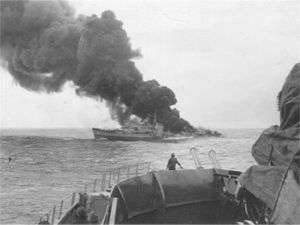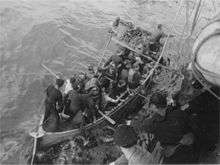HMS Gurkha (G63)
 HMS Gurkha sinking after being torpedoed | |
| History | |
|---|---|
| Name: | HMS Gurkha |
| Namesake: | Gurkha |
| Ordered: | 31 March 1938 |
| Builder: | Cammell Laird & Co Ltd, Birkenhead |
| Laid down: | 18 October 1938 |
| Launched: | 8 July 1940 |
| Commissioned: | 18 February 1941 |
| Identification: | pennant number: G63 |
| Fate: | Sunk, 17 January 1942 |
| General characteristics | |
| Type: | L-class destroyer |
| Displacement: |
|
| Length: | 362 ft 3 in (110.4 m) o/a |
| Beam: | 37 ft (11.3 m) |
| Draught: | 10 ft (3.0 m) |
| Installed power: | 48,000 shp (36,000 kW) |
| Propulsion: |
|
| Speed: | 36 knots (67 km/h; 41 mph) |
| Range: | 5,500 nmi (10,200 km; 6,300 mi) at 15 knots (28 km/h; 17 mph) |
| Complement: | 190 |
| Sensors and processing systems: |
|
| Armament: |
|
HMS Gurkha was an L-class destroyer in Britain's Royal Navy during World War II. She was originally to be named Larne in line with her class letter. However after the Tribal-class Gurkha was sunk in April 1940 the officers and men of the Gurkha Regiments each subscribed one day's pay to replace her and Larne was renamed before launching.
Her only commanding officer (Commander C N Lentaigne) was brother of Joe Lentaigne who was an officer in the 4th (Prince of Wales' Own) Gurkhas.
Construction and design
On 31 March 1938 an order was placed with Cammell Laird for Larne, one of eight L-class destroyers ordered that day and was laid down on 18 October 1938, the first of her class.[1] In April 1940, the Tribal-class destroyer Gurkha was sunk off Norway, and in June it was decided to rename Larne as Gurkha to continue the relationship between the ship and the Gurkha Regiment.[2] She was launched on 8 July 1940[1] by Mary, daughter of Winston Churchill.
The L class was intended to have a main gun armament of six QF 4.7 inch Mark XI guns in three enclosed twin Mark XX mounts, but delays in production of the new gun mount resulted in the July 1940 decision to complete four of the class, including Gurkha, with a revised main gun armament of eight QF 4-inch (100 mm) Mk XVI naval guns in four twin mounts.[1][3] Close-in anti-aircraft armament consisted of a single quadruple 2-pounder (40 mm) "pom-pom", two single 20 mm cannon and two quadruple Vickers .50 machine gun mounts. Eight 21-inch (533 mm) torpedo tubes were carried in two quadruple mounts.[4] 110 depth charges were carried.[1][5]
Gurkha reached a speed of 33.73 knots (62.47 km/h; 38.82 mph) on sea trials and was completed on 18 February 1941.[6]
Service history
On commissioning, Gurkha joined the 11th Escort Group.[7] On 25 March 1941, the steamer Beaverbrae was sunk by German bombers and Gurkha, together with the destroyer Tartar rescued Beaverbrae's crew. While returning to Scapa Flow the next day, Gurkha collided with a wooden drifter, sinking the fishing boat and sustaining serious damage. She was under repair at Rosyth until June 1941.[7][8]

Following repair, Gurkha was deployed on convoy escort duties in the Western Approaches.[2] She guarded Malta Convoys (1941), destroyed the Italian submarine Adua, and guarded United Kingdom to Gibraltar convoys.
She was torpedoed by U-133 off Sidi Barrani on 17 January 1942 and sank after 90 minutes. The surviving crew members were saved by the Dutch destroyer Isaac Sweers. Coordinates: 31°50′N 26°15′E / 31.833°N 26.250°E[9]
Citations
- 1 2 3 4 English 2001, p. 100.
- ↑ Whitley 2000, p. 122.
- ↑ Lenton 1970, pp. 128–129.
- ↑ Gardiner and Chesneau 1980, p. 41.
- ↑ English 2001, pp. 100–101.
- 1 2 English 2001, p. 104.
- ↑ Kindell, Don (7 April 2012). "Naval Events, March 1941 (Part 2 of 2): Saturday 15th - Monday 31st". British and Other Navies in World War 2 Day-by-Day. naval-history.net. Retrieved 21 June 2014.
- ↑ "HMS Gurkha (II)(G63) of the Royal Navy". U Boat.net. Retrieved 18 January 2013.
References
- Blair, Clay (2000). Hitler's U-Boat War: The Hunters 1939–1942. London: Cassell & Co. ISBN 0-304-35260-8.
- English, John (2001). Afridi to Nizam: British Fleet Destroyers 1937–43. Gravesend, UK: World Ship Society. ISBN 0-905617-95-0.
- Gardiner, Robert; Chesneau, Roger, eds. (1980). Conway's All The World's Fighting Ships 1922–1946. London: Conway Maritime Press. ISBN 0-85177-146-7.
- Lenton, H.T. (1970). British Fleet and Escort Destroyers Volume One. London: Macdonald & Co. ISBN 0-356-02950-6.
- Rohwer, Jürgen; Hümmelchen, Gerhard (1992). Chronology of the War at Sea 1939–1945. London: Greenhill Books. ISBN 1-85367-117-7.
- Smith, Peter C. (2010). Fighting Flotilla: RN Laforey Class Destroyers in WW2 (2nd ed.). Barnsley, UK: Pen & Sword Maritime. ISBN 978-1-84884-273-1.
- Whitley, M. J. (2000). Destroyers of World War : An International Encyclopedia. London: Cassell & Co. ISBN 1-85409-521-8.